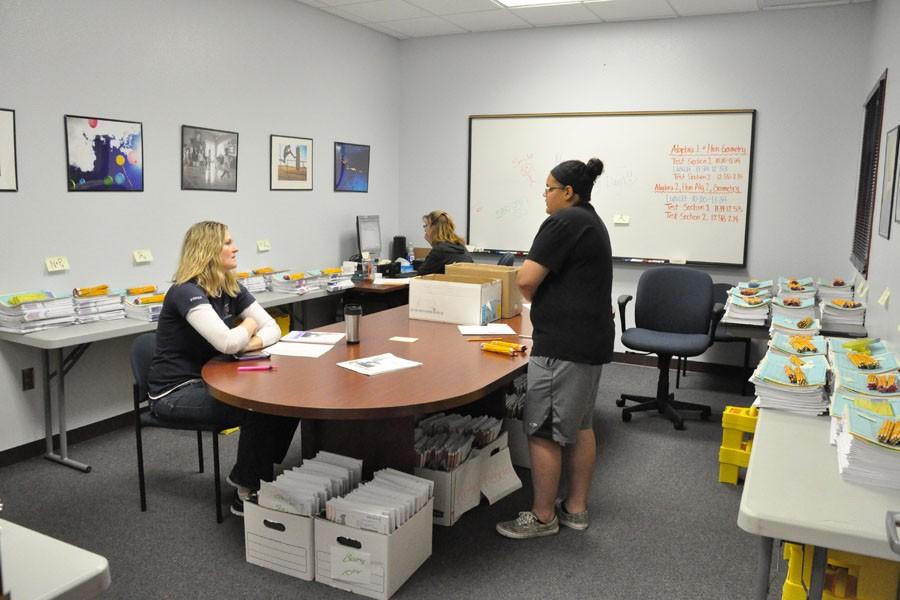State testing disrupted learning more than helped
Counselors Kirstin Gregg and Marsie Shealey, with student Tyler Gutti, organize AzMERIT supplies preparing for distribution.
April 23, 2015
Now that the 2015 AzMERIT testing season has come to a close, let’s take a moment to reflect.
Or exhale.
The term’s circus, zoo, nightmare have bounced around the testing circuit this spring, but why? Politicians like Gov. Doug Ducey and Superintendent of Public Instruction Diane Douglas have gone on the record against this test, but haven’t really said why we should be afraid of it.
For as long as PHS has been open, all students had to pass a sophomore-level exam (Arizona’s Instrument to Measure Standards) in order to graduate. But with the implementation of the state’s new test – Arizona’s Measurement of Educational Readiness to Inform Teaching (AzMERIT) – it seems that school officials have been on high alert, and groups within the community have been squeaky wheels of slanted information, trying to scare families into “opting-out” and even protesting the schools.
But testing has been a part of education in Arizona for years – what is different about 2015?
This school year marks the first for the AzMERIT standardized test – an exam which measures students’ knowledge in math, reading and writing.
The state changed its test because of the Arizona College and Career Ready Standards (AZCCRS, which is our state’s way of saying Common Core); now high schools are required to take a test toward the end of the year to measure how much they learned that year.
According to the Arizona Department of Education, this program was implemented to ensure that all students have the academic knowledge and skills necessary to succeed in college, career, and life.
“Standardized testing is something you have to do because you have to see where you compare with other students around the country,” principal Dan Serrano said. Serrano continued stating that because this was the first year AzMERIT was administered, it carried many ‘hiccups’ and that the Arizona Education board is going to have to fix those.
For example, the window of testing was far too wide. The paper-based window of the testing period was from April 13-24: more than ten days for information to leak between students and teachers from different schools.
Not many students were surprised when they saw an informative essay about an observatory for freshmen; an argument essay about what is happiness for sophomores; and an argument essay about what makes a game good for juniors.
“I don’t believe that you were supposed to know the writing prompt before you opened the test booklet,” said Serrano.
On top of that, it was rumored that the test would enhance rigor. AIMS was inevitably a simple test compared to others, but AzMERIT proved to be just as easy, if not more.
“Most of my class only took half of the given time to complete the test,” junior Riley Marshall, shared. “It was easy for everyone to pass which I consider to be a negative.”
The state tried to make it more rigorous, sort of. Some questions had multiple correct answers and the writing prompt had sources we could cite for evidence; all in all, the test proved to be just as simple.
Another flaw was the lack of accountability. Why are students taking this test? Since this is the pilot test, the school system gave out little on how students’ futures will be affected by this test. Is passing needed to graduate? Will it be a grade in classes? Can colleges see scores? The answer: no, no and no.
“There’s a lot of politics with the AzMERIT,” Serrano said, noting that it is mandatory for all students to take the test. “It’s kind of interesting to have kids take these tests.
“For me, [the tests] are very important because every year I have to sit down with my superintendent and guess what the first thing she pulls out: test scores,” Serrano said. He also noted that Perry’s test scores are compared to other CUSD scores, as well as scored from neighboring Higley and Gilbert school districts.
Among other rumors were that students were allowed to opt-out, a rumor that Serrano quickly dispelled by saying “there is no opt-out. You have to take the test.”
Along with that was the scandal of “hacking.” Many students and parents thought that the AzMERIT testing system could collect their social security number and spread it on the Internet. It was rumored that the Arizona testing database has been hacked in the past so families were worried that it would affect their personal lives if they took the test. Serrano has assured the student body that no personal information has been given out.
So where are we now? Students and school faculty were the victims of a political battle by the state’s top politicians – Ducey, Douglas, and others say we should hate Common Core and that everything surrounding it is corrupt, but they offer no solutions other than going back to the more lax, AIMS-era state standards which helped our us become the education-bottom feeder that it is today.
Politicians need to include school officials and teachers more in the future of students, including standards and testing. Politicians need to enhance their communication skills and listen to the people they represent.
In the end, that’s all we ask.


